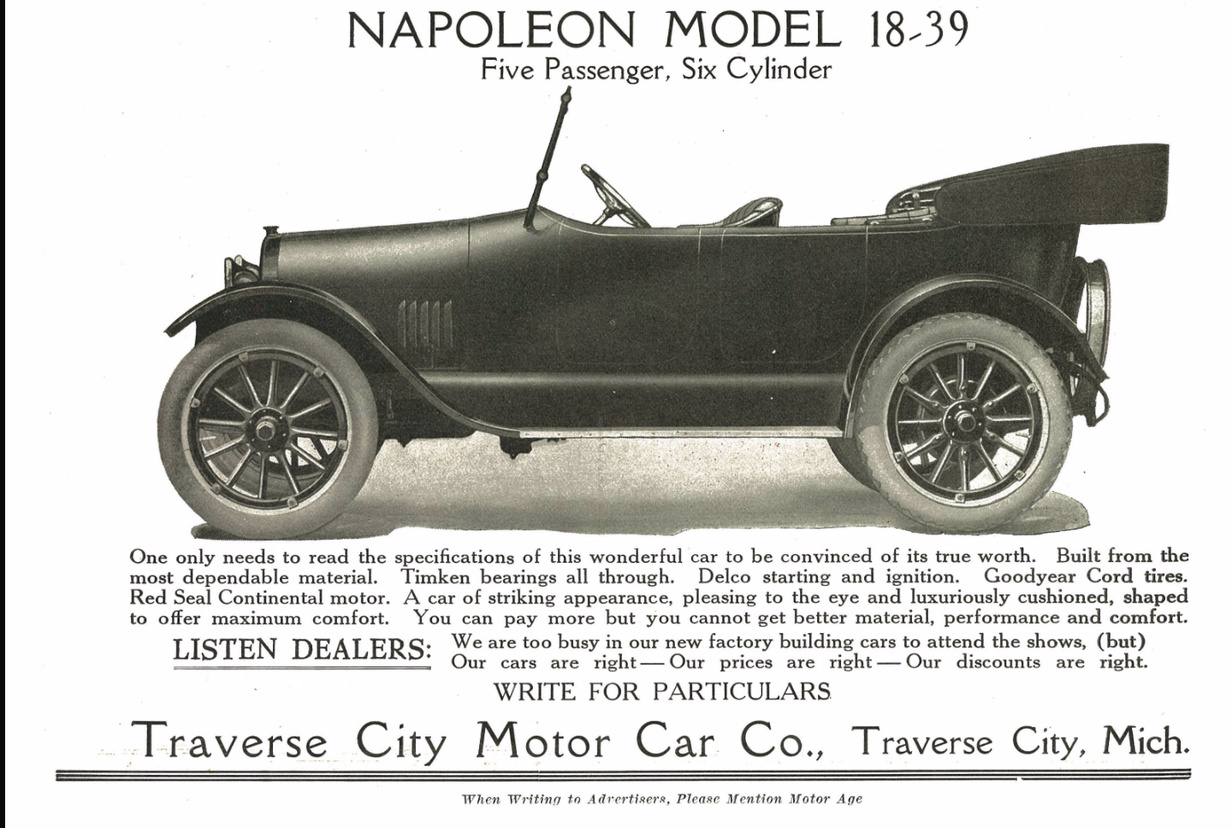
Traverse City's Automotive History
By Ross Boissoneau | Jan. 24, 2021
A speed limit of eight miles per hour. Traverse City’s first automobile fatality. The Napoleon.
A look back at the history of the automobile in Traverse City showcases technological advances and business failures, the foibles of early driving machines and more.
An entry in the Daily Eagle newspaper dated Sept. 8, 1903, notes that automobiles “shall not be run at a speed exceeding eight miles an hour” in an area defined by Garfield Avenue, Carver and Seventeenth Streets on the south and Elmwood Avenue on the west. However, speed demons outside that area were given more leeway, as cars could go up to 12 miles per hour elsewhere in the city.
Just seven years later, the city suffered its first automobile-related fatality. According to Traverse City historian Larry Wakefield in his book The Way It Was, Nelson Smith of Elk Rapids was driving a party of three other teens in an Apperson Jackrabbit on Fifth Street – the city’s first paved road – on Oct. 27, 1910. The Jackrabbit was a speedster produced by the Kokomo, Indiana, company between 1907 and 1926, when the company dissolved.
Winter had arrived early, and there were patches of snow and ice on the roadway. When Smith tried to slow down for a turn at the end of the street, the car skidded, jumped the curb and flipped over on the railroad tracks, before rolling down an embankment to the water’s edge.
Smith and his passengers Clara Ramsay and Leslie Wagley only suffered cuts and bruises, but Clara’s 18-year-old sister Blanche was pinned under the vehicle and unconscious. Despite the ministrations of Dr. E. H. Minor, the first person on the scene, she died the next morning at her home on Eleventh and Bohemia Streets.
Historically, the state’s fatality rate climbed steadily from 1915 to 1927, from 600 to an early peak of 1,410 in 1927. According to Michigan Traffic Crash Facts (MTCF), they then leveled off before peaking again a decade later at 2,170.
Data from MTCF, which begins in 1940, shows fatalities as a ratio to population and the number of vehicles peaked in 1941 before beginning a nearly steady downward trend. In 1941, there were 3.95 fatalities per 10,000 people, and 12.55 per 10,000 registered vehicles. In 2019, the latest year for which the figures are available, they are .99 and 1.08, respectively. The total number of fatalities peaked in 1969 at 2,487.
Traverse City history buff Anne Magoun says entries she found in her grandmother’s diary demonstrated just how newfangled the early motorized vehicles seemed. “From my grandmother’s diaries (circa 1911-1913), I learned that cars were referred to as ‘machines,’ as in ‘Joe stopped by today and we went out riding in his machine.’ I don’t believe she ever called them cars or autos or automobiles,” she says.
By the mid-1910s, Traverse City was ready to embrace the auto industry, particularly since it was looking for new businesses to stimulate the local economy. In 1916, the city’s largest employer, the Oval Wood Dish Company, left town and relocated to New York state. That prompted the city fathers to seek another large-scale employer, and they found an Ohio company considering a move.
The Napoleon Auto Manufacturing Company in Napoleon, Ohio, was a victim of its own success, with orders for more automobiles than it had the capacity to produce at its original location. So Napoleon up and moved north, becoming the Traverse City Motor Company. In 1919, the facility produced 125 cars and another 125 trucks. In 1920, the name was changed back to the Napoleon and its trucks became so popular, the car line was dropped.
Alas, just three years later the company declared bankruptcy, a victim of delays in its supply line and a recession. Today Napoleons are all but consigned to the dust bin of history, with only one such vehicle known to exist.
Jeff Peek of Hagerty penned an article for the company’s website about the Napoleon. In it, he noted, “In fact, the burned-out remains of a 1919 truck that local auto enthusiast Dennis Kuhn found in Colorado and restored in 1996 may be the only Napoleon in existence.”
A similar article in the Traverse City Business News in 2012 fleshed that story out: “Dennis Kuhn, an organizer of the Buckley Old Engine show … wanted to restore a Napoleon truck, though none could be found. In 1997 he saw an advertisement in Hemmings Motor News for a 1919 Napoleon truck in startling disrepair. Most of the original wood, including the steering wheel, the body and the wheel spokes, had been burned in a Nebraska prairie fire. He bought it anyway and he and retired machinist, Carl Kreiser, spent two years restoring it. In 1999 it was displayed at the Buckley Old Engine Show and in July (of 2012) it took the monthly place of honor in the Hagerty window.”
Photo courtesy Jeff Peek/Hagerty
Comment






